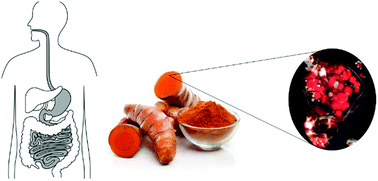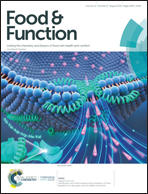Food matrix and co-presence of turmeric compounds influence bioavailability of curcumin in healthy humans†
Abstract
The natural food-derived compound curcumin (from turmeric root) is known for its anti-inflammatory and anti-oxidant effects. However, due to its poor solubility when consumed in isolation, it is poorly bioavailable. In this crossover study we compared the bioavailability of curcumin from a meal containing either curcumin powder, turmeric powder or grated fresh turmeric root, all containing 400 mg of curcumin, along with mashed potatoes and cream. Healthy male participants consumed the meals following overnight fasting, and postprandial blood samples were taken to measure plasma curcuminoids (curcumin, dimethylcurcumin (DMC) and bisdimethylcurcumin (BDMC)). All plasma curcumin values refer to total curcumin (sum of free and conjugated curcumin). The meals were also analysed using confocal laser scanning microscopy to determine the location of curcuminoids. Both of the turmeric meals produced significantly higher amounts (p < 0.05) of plasma curcuminoids at 1–3 hours after the meal was consumed, as compared to the curcumin powder. Plasma curcumin Cmax was 4.9 ng ml−1 95% CI (confidence interval) [2.2, 7.5] for the fresh turmeric meal, 8.4 ng ml−1 95% CI [4.4, 12.48] for the turmeric powder meal and 0.19 ng ml−1 95% [−0.08, 0.47] for the curcumin powder meal. Plasma DMC and BDMC were significantly higher (p < 0.05) following the turmeric powder meal, compared with the fresh turmeric meal and the curcumin powder meal. Microscopy images showed that the curcuminoid particles were mostly confined within curcuminoid cells in the fresh turmeric meal. They were unconfined but in clusters in the turmeric powder meal, while the curcuminoid particles appeared smaller in the curcumin powder meal. Conclusion: curcumin bioavailability is enhanced when consumed as fresh or powdered turmeric, which could be due to the co-presence of other turmeric compounds and/or a turmeric matrix effect.



 Please wait while we load your content...
Please wait while we load your content...